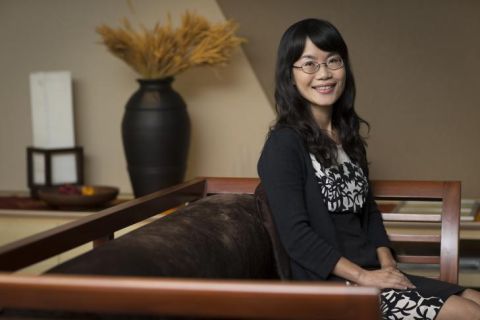
(Above) Professor Tang Hang Wu, Director of the SMU Centre for Cross-Border Commercial Law in Asia (CEBCLA) speaking at the ANU-SMU-Reading Research Forum.
At the inaugural ANU-SMU-Reading Research Forum, three experts discussed contemporary issues in property law.
By Lee Ying Ying
SMU Office of Research – For the uninitiated, applying the law may seem straightforward - following a set of rules stated in black and white. In many cases, however, strict application of the rules can appear harsh, especially when it comes to property law. To achieve a fairer outcome, one can supplement the rules with a set of flexible principles, also known as equity.
But what exactly constitute “fair” outcomes in the realm of property law? This was the question tackled by a panel of experts at the Australian National University-Singapore Management University-Reading University (ANU-SMU-Reading) Research Forum held over 10-11 September, 2015.
Hosted by SMU’s Centre for Cross Border Commercial Law in Asia (CEBCLA), the inaugural forum also addressed in three other panel sessions the emerging challenges in commercial law relating to the United Kingdom (UK), Australia and Singapore and the contemporary issues in international law.
Taking a holistic view of a case
Opening the panel on property law was Associate Professor Pauline Ridge, Director of the ANU Centre for Commercial Law. She sought to uncover the “hallmarks” of Australia’s version of equitable doctrine by focusing on the judgment handed down by the Honourable Paul Finn in the case of Grimaldi versus Chameleon Mining.
This case revolved around the alleged misuse of funds and shares of a mining company, Chameleon Mining. Philip Grimaldi, a “shadow” director of the company, was accused of misusing his authority as the director of Chameleon Mining by buying iron ore tenements that benefited his own company, Murchison Metals. The courts judged that Grimaldi had breached his fiduciary duty to act solely in the interests of Chameleon Mining.
Professor Ridge examined how the judge adopted a holistic—or “in the round”—consideration of facts surrounding the case before reaching his verdict. Given the complexity of the Grimaldi case, judiciary discretion and flexibility were necessary, she said.
“[An important hallmark of Australian equity] is a focus on basal principles and organising ideas of equitable doctrine, and a corresponding rejection of narrow, rigid doctrinal formulae. In determining the basal principle and organising ideas, explicit acknowledgement of policy and the underlying norms of the law are essential,” said Professor Ridge.
The grey area of trusts
What followed was a presentation by Professor Tang Hang Wu, director of CEBCLA at SMU. He proposed ways in which judge-made equitable doctrine could be applied in the face of a growing number of statutes passed by the legislation that largely cover the same ground.
Professor Tang also proposed to identify the purpose of a statute using both objective and subjective means. This entails studying the aims pursued by the statute as well as the language in which it is cast.
Professor Tang brought up the example of how the Housing Development Board (HDB) prohibits trusts—arrangements where one person (the trustee) holds property for the benefit of another party—to be created in relation to HDB flats. The HDB is a public housing agency that builds and regulates the sale of public housing in Singapore, and its policy in this regard aims to prevent a situation where an ineligible owner (for instance a foreigner) benefits from an indirect ownership of a HDB flat through a trust. But in cases where the trust is between husband and wife, Professor Tang reasoned that equitable doctrine may be applied as long as the beneficiary is eligible to own HDB property in their own name.
“I think that modern judges cannot act in a way where they blatantly ignore statutes. If they want to apply equitable doctrine in the face of statutes, it must be done in a way where it does not undermine the purpose of the statute,” Professor Tang explained.
When individuals share a plot of land
In the closing presentation, Professor Nick Hopkins from University of Reading, UK, outlined an ongoing joint research effort exploring the law that governs relationships between individuals sharing a plot of land.
“The attention of current scholarship is on the relationship between a property owner and the rest of the world, or on transactions taking place between property owners. As such, what it tends to overlook is the dynamics of property relationships between the parties to a property right and between individuals who use a shared physical space,” Professor Hopkins noted.
Professor Hopkins described the case of Bradley versus Haslin, which concerned a dispute about whether the gate that allowed for access to their homes from the main road should be open or closed. Crucially, the driveway was located on land owned by the Haslin family, although the Bradleys had the right to use the driveway to get to their house. In this ruling, the judge emphasised that the various prior owners of both homes had developed a harmonious approach to this matter and he therefore urged the current occupants to let the principles established over the course of that period guide them in resolving the matter.
Navigating human relationships is never simple, and the laws governing these relationships need to be flexible and allow space for interpretation, the three panellists agreed. The talks by Professors Ridge, Tang and Hopkins ended with a lively Question-and-Answer session with the Forum participants.
|
|
|
Associate Professor Pauline Ridge, Director of the ANU Centre for Commercial Law (left), and Professor Nick Hopkins, University of Reading, UK (Right) speaking at the ANU-SMU-Reading Research Forum.
See More News
Want to see more of SMU Research?
Sign up for Research@SMU e-newslettter to know more about our research and research-related events!
If you would like to remove yourself from all our mailing list, please visit https://eservices.smu.edu.sg/internet/DNC/Default.aspx

